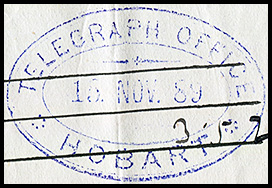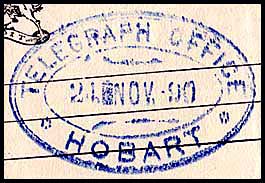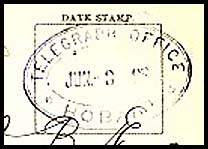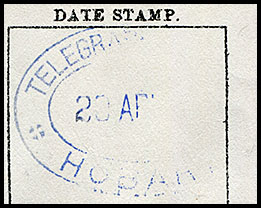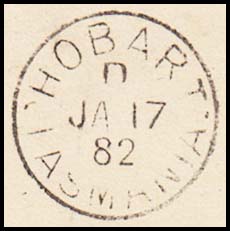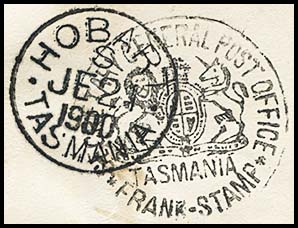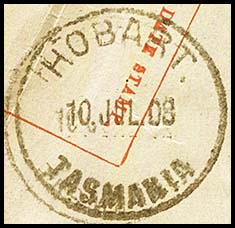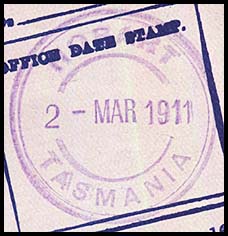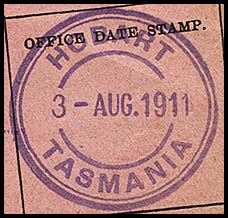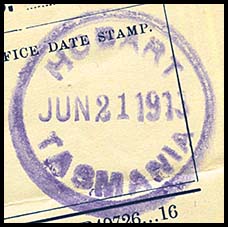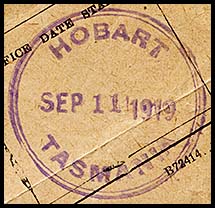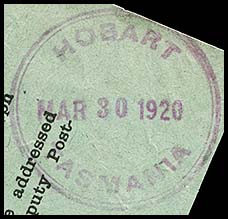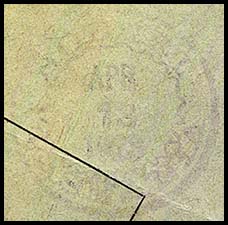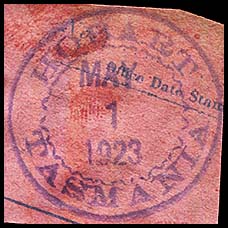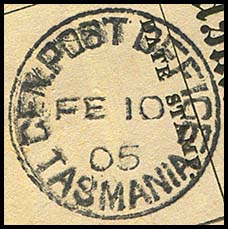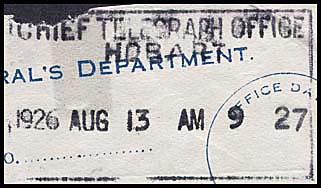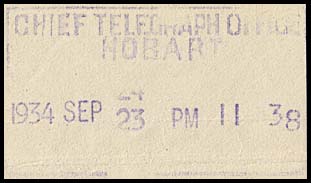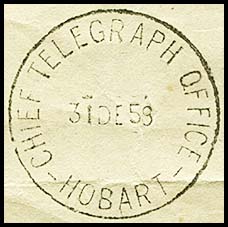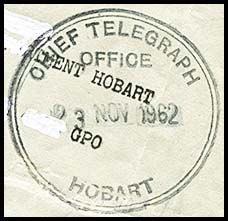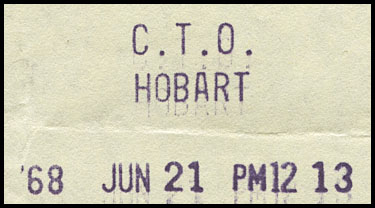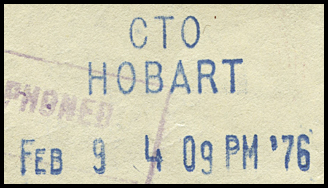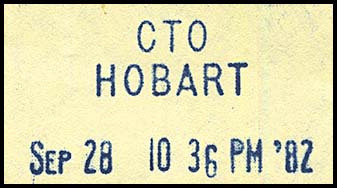- Australia 1901-1988
- New South Wales
- Queensland
- South Australia
- Tasmania
- Victoria
- Western Australia
- International
- Special aspects
Details included on this page are:
- The General Post Office;
- The Chief Telegraph Office;
- The Coastal Radio Station.
- Date stamps used at the CTO during the Colonial and Interim periods:
Frank Stamps;
Telegraph Office (ovals);
Hobart - rectangular;
Hobart - circular (used on telegrams);
Gen(eral) Post Office. - Date stamps used at the CTO during the Australian period (post 1917):
Chief Telegraph Office;
Phonogram Supervisor;
C.T.O. (unbordered rectangular rubber date stamps).
- See also the following Slogan Cancellations used at Hobart:
* A Telegraphic Code Address ...;
* Other slogans used at Hobart.
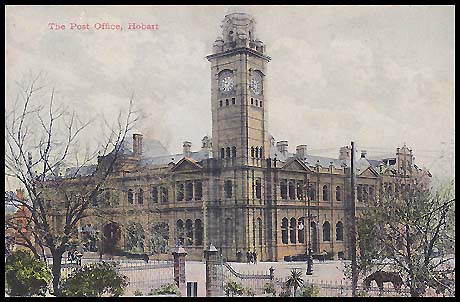 |
The Gazette of August 17 1822, contains an announcement of the appointment of John Thomas Collicott as Postmaster at Hobart Town. Mr. Collicott was an auctioneer, his store being situated in Murray Street where the Derwent livery stables were later situated.
On June 1, 1832 the Post Office became a Government Department and 20 post offices were established under the control of the Auditor of Civil Accounts and Mr. Stephen Tunbridge Hardinge, who had served six or seven years in the G.P.O., London, was appointed for the purpose of assisting in conducting the Post Office business. Mr. Hardinge afterwards became the first Secretary to the Post Office under Ministerial control. |
In 1837 the Post Office was removed to premises belonging to David Lord situated at the corner of Collins and Elizabeth Streets (now the All Nations Hotel) until the business was removed to the building just vacated - about 1860.
| Following the introduction of telephones in 1882, the Post Office and Electric Telegraph Departments merged in 1894 as the Post and Telegraph Department.
The photograph at the right shows the alterations in progress for the amalgamation of the Postal and Telegraph Departments. The building was on Macquarie Street in Hobart and the picture shows the intersection of Murray and Macquarie Streets looking down Macquarie Street. |
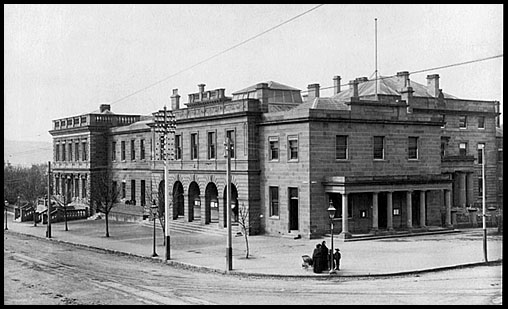 |
Examples of the discussions and the Parliamentary debates surrounding the merger are provided elsewhere.
On 30 June 1894, the Mercury reported that "The contemplated extension of the public buildings in Macquarie Street to provide the extra accommodation supposed to be required for the amalgamation of the Post and Telegraph Departments is now not found to be necessary and will not be proceeded with except in regards to the erection of a new strong room and other unimportant particulars". The Treasurer also announced that "the required accommodation in connection with the amalgamation of the Post and Telegraph Departments can be provided for about £1,000 instead of about £5,000 as expected".
Further details on the administrative responsibility for the Telegraph Department and the merger with the Postal Department are provided elsewhere.
On 14 February 1901 post, telegraph and telephone services came under the control of the Commonwealth Government.
The P&T Department moved from corner of Macquarie and Murray Streets to the corner of Macquarie and Elizabeth streets as from Sunday 3 September 1905. The present structure is the fourth official post office that Hobart has possessed since the first settlement of Tasmania in 1803.
A series of observations on the Post & Telegraph Departments were recorded in a Letter to the Editor in 1891 which, in part, related directly to the discussions for a new building.
The first Hobart Telegraph Office was housed in a stone building on the Franklin Wharf which had previously been occupied by the water police.
Clemente (1975) analysed the post marks used to 1901 at Hobart. Part of his analysis included the telegraph postmarks. He shows few are easily identifiable as such but demonstrates why apparently ordinary postal designs can be classified as being made for telegraphic use.
|
A circular hand stamp was also used for official mail sent from the Electric Telegraph Department. The use of the Frank Stamps enabled mail to be sent without the use of stamps to pay the postage cost.
|
||
| Used in blue.
Earliest date recorded: 1888. Rated: RRR. |
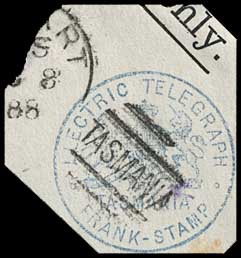 Used in 1888. |
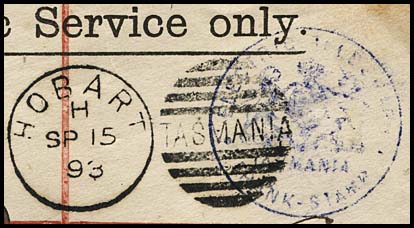 15 September 1893. Used on TC-EA-1. |
| Telegraph Office/Hobart.
Rubber date stamps appear to have been primarily used at the GPO on the counters and in the telegraphic section. They probably were not used in the mail room section. |
| Telegraph Office/Hobart. | ||
RO6-TO: Words in the outer ring are separated by open rosettes of 6 parts at each end of the oval enclosure and below the horizontal.
|
|
|
RO6-TO: Words in the outer ring are separated by open rosettes like the above.
|
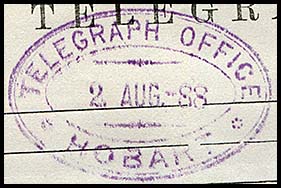 2 August 1888 (earliest recorded date). Used on TC-DO-4A. |
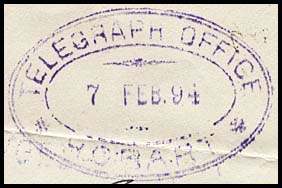 7 February 1894. Used on TC-DO-4A. |
RO6-TO: Words in the outer ring are separated by open rosette stops.
|
|
|
RO6-TO. Words in the outer ring are separated by cross stops of 4 parts at each end of the oval enclosure and below the horizontal (see Clemente (1975) p.37). |
|
|
Used on TC-DO-5A (this type of form has an ERD of August 1896).
|
|
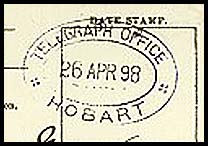 26 April 1898. Used on TC-DO-5A. Prestige Philately August 2005 Lot 411. |
Rectangular rubber date stamps with Hobart.
|
|
Date and progressive number separated by a decorative unfilled stop.
|
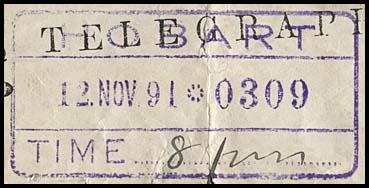 12 November 1891. Used on TC-DO-4C. |
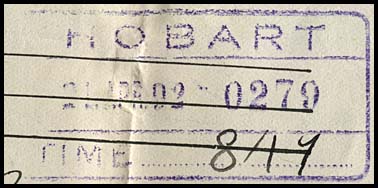 21 April 1892. Used on the very rare TC-DU-1. Provenance: Clemente, Johnstone. |
|
Date and progressive number separated by a decorative cross.
|
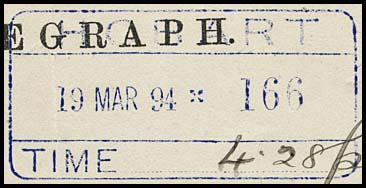 19 March 1894. Used on TC-DO-4C. |
Date and progressive number separated by a decorative vertical cross.
|
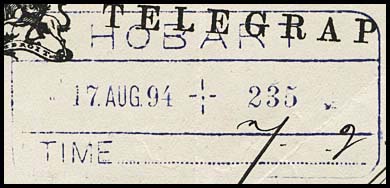 17 August 1894. Used on TC-DO-4C. |
| HOBART TASMANIA Type 1: Circular with a two line date and two digit year. Date stamps with this format were also used on postal items but with a counter number/letter(s) below HOBART. |
Tasmanian Stamp Auctions |
Frank Stamp for the General Post Office. |
Words separated by dot stops.
|
 30 December 1896. Used on TC-DO-5D. Dots near circumference. |
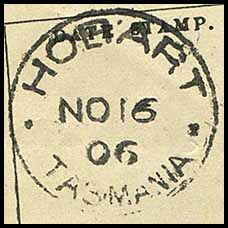 16 November1906. Used on TC-DO-5D. Dots centered on letters. |
| Words separated by open circle stops centered with the letters H and T of Hobart.
|
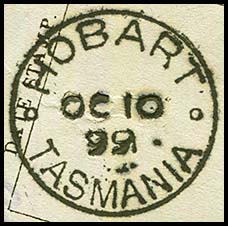 10 October 1899. Used on TC-DO-5A. |
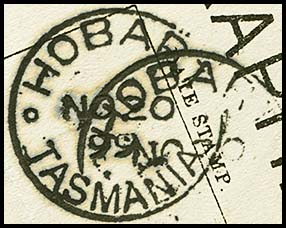 20 November 1899. Used on TC-DO-5A. |
Words separated by 1 mm arcs.
|
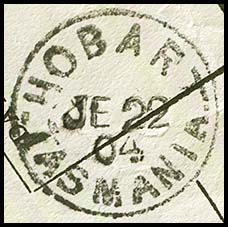 22 June 1904. |
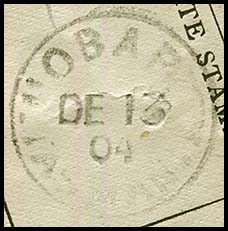 13 December 1904. |
HOBART Type 2: Circular with a one line date and two digit year.
This date stamp was also used post 1900 - allegedly most frequently on high value pictorials. |
|
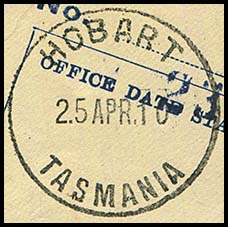
25 April 1910. Used on TI-DO-3A. |
| HOBART TASMANIA (miscellaneous). The circular design with HOBART at the top and TASMANIA at the base was used in several formats to date stamp telegrams. The basic design as shown above was used for the main first issue of date stamps to various offices. At HOBART, there were some variations on the basic design. |
||
RC3-HOB:
|
Used on TI-DO-3A (two strikes). |
Used on TI-DU-3. |
RC2 - HOB
|
Used on TI-DO-3D. |
|
RC2 - HOB Used in violet; 11 September 1919 to Diameter: 37 mm. Rated: RRRR. Number in the Census on telegrams: 2. |
Used on TI-DU-4. |
Used on AE-DO-1. |
RC4: Rubber handstamp in violet. Three line date.
|
|
|
|
Two line date - two digit year.
|
Used on TI-DO-1B. |
|
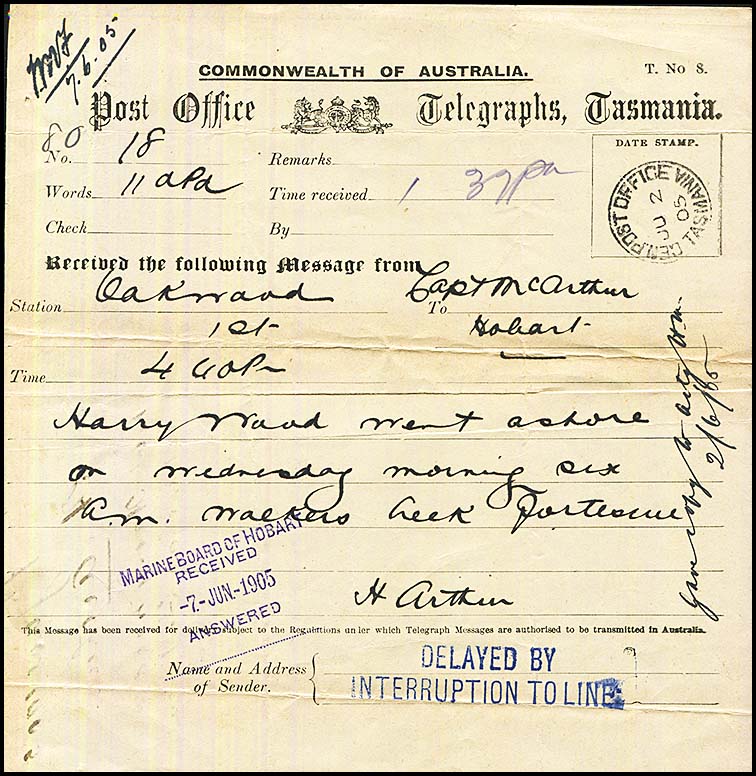 2 June 1905. Used on TI-DO-1B showing the scarce DELAYED BY/INTERRUPTION TO LINE hand stamp. |
||
Chief Telegraph Office/Hobart
(post 1917) period).
Rectangular format.
|
Used in black on AE-DO-3B. |
Used in violet on AB-GBF-34A. |
| Steel circular date stamp (SC1-CTO-1).
4 mm gap between H and O.
|
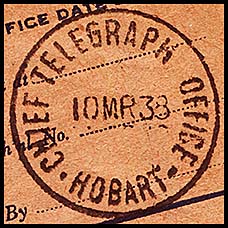 10 March 1938. Used on AB-DU-7. |
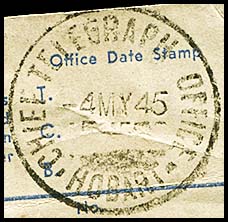 4 May 1945. Used on AW-DO-9Eb. |
| Steel circular date stamp (SC1-CTO-1).
2 mm gap between H and O.
|
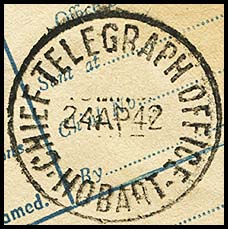 24 April 1942. Used on AB-DO-7Bg. |
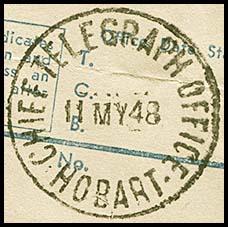 11 May 1948. 11 May 1948.Used on AW-DO-10B (46). |
Steel circular date stamp (SC1-CTO-2). 1 mm gap between H and O.
|
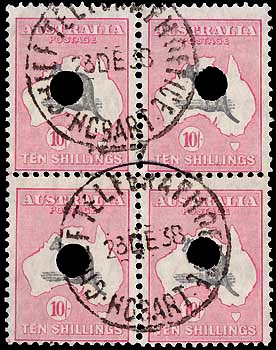 23 December 1938. Used on 10/- grey and pink Kangaroo on Map printed paper with the C of A watermark. Has four 5 mm telegraph punctures. |
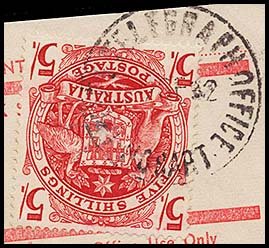 2 September 1952. On 5/- Arms affixed to an Urgent transmission form. |
Steel circular date stamp ((SC1-CTO-3).
|
Used on AA-DO-13B |
|
Steel circular date stamp ((SC1-CTO-3).
|
 31 December 1963. Used on AA-DO-13B. |
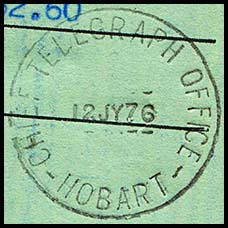 12 July 1976. Used on phonogram AA-PO-7B (73). |
| Chief Telegraph/Office/Hobart.
Made from rubber - RC1 - CTO.
|
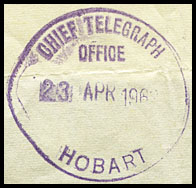 23 April 1963. Used on AA-DO-13B (see below). |
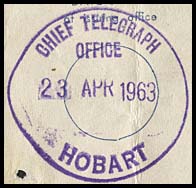 23 April 1963. Used on AW-RO-8B. |
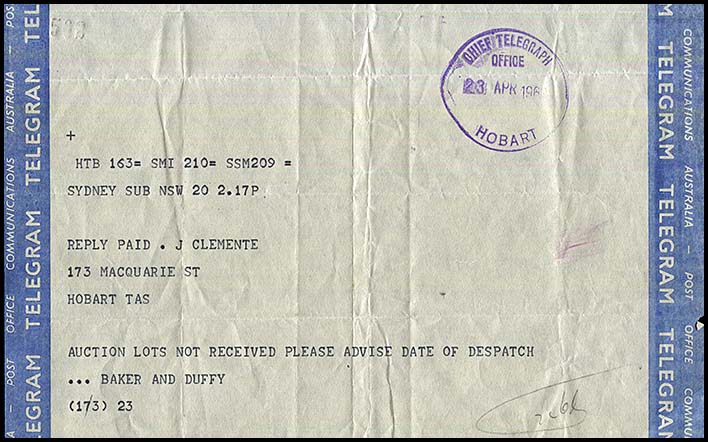 Provenance: Clemente, Johnstone. |
Distorted date stamp used on 23 April 1963 on AA-DO-13B. Dr John Clemente was one of Tasmania's most distinguished philatelists. Baker and Duffy owned one of Sydney's best known Stamp Shops. |
|
Made from steel - SC2 - CTO.
|
Used on AA-DO-13B. |
|
|
See telegram used in 1970 with this datestamp (AA-LO-4B). |
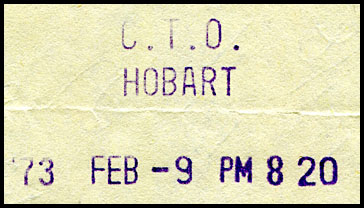 9 February 1973. Used on AA-DO-13D |
|
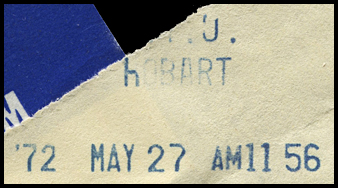 27 May 1972 in blue. Used on AA-DO-13C . |
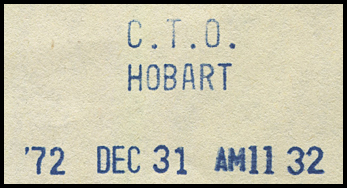 31 December 1972 in blue. Used on AA-DO-13C. |
|
Used on AA-DO-13D. |
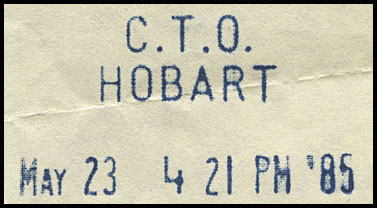 23 May 1985. Used on AT-DO-15B. |
|
 14 October 1974 on an official Departmental envelope. |
 3 January 1975. Used on AA-DO-13D with an OVERSEAS label. |
|
Used on AA-DO-15A for an URGENT Telegram |
Used on AT-DO-15A
with a |
